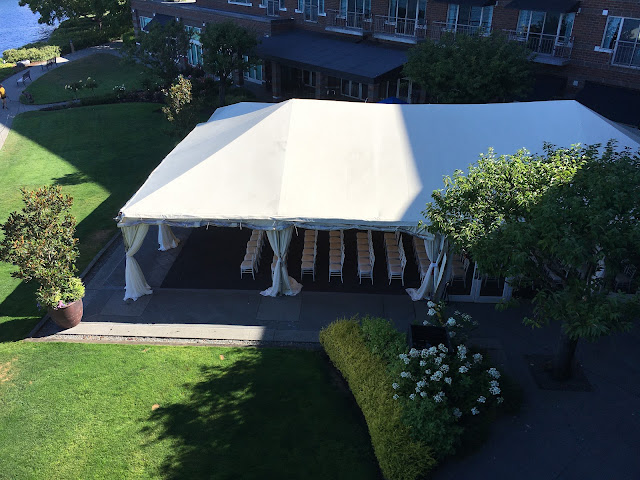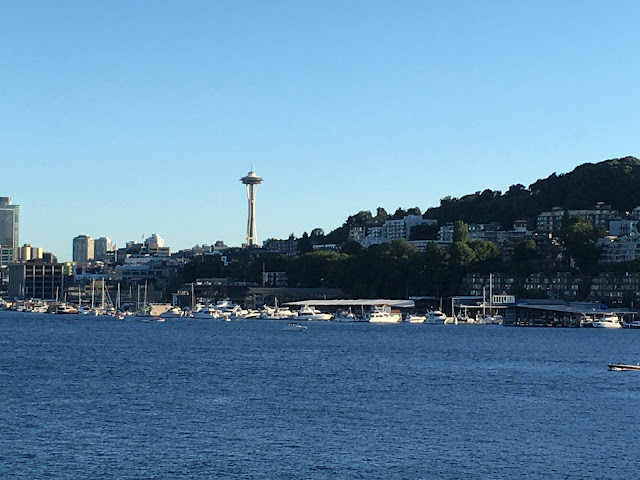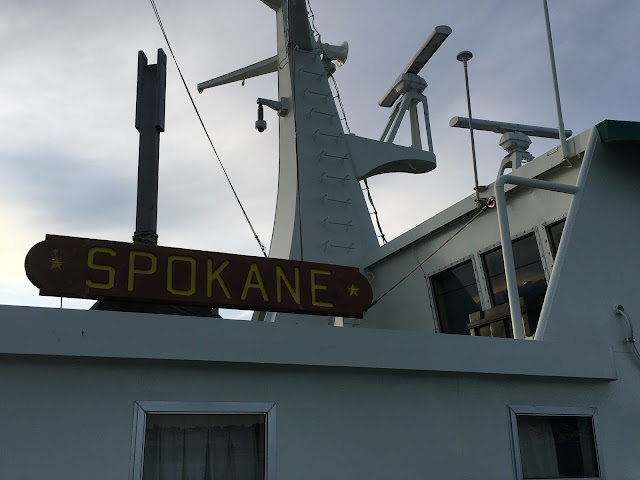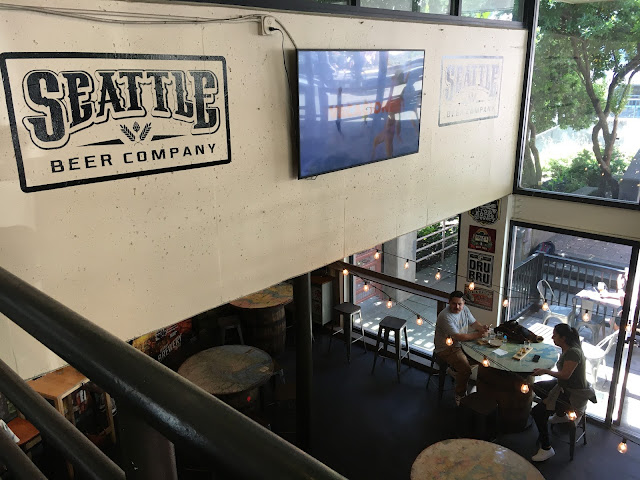The city of Seattle (named after the Suquamish and Duwamish Chief Si'ohl) is the only major U.S. city named after a Native American. And while it has a colorful back story--prostitution, liquor, gambling, fire, railroads, lumber, gold--today, it has a cultural, outdoorsy, and innovative vibe--Starbucks Coffee, craft beer, grunge music, Pike Place Market, the Space Needle, the Seattle Great Wheel, Microsoft, Google, and Amazon.
I'm not sure what first intrigued me about Seattle--was it Nirvanna, Pike Place Market, or the unique Space Needle? Nevertheless, in my 20s (aka the 1990s), I made the decision that visiting Seattle was essential, and I was determined to see it. Fast forward twenty-six years later, and now I was not only witnessing it for myself, but with Hubby and Little Lewie by my side, too.
To understand Seattle is to first understand its location and climate. Named the Emerald City in 1982, it is considered the "jewel of the Northwest" because of its lush evergreen trees. On the west side of Seattle is the Olympic Mountain Range and the salt waters of Puget Sound. On the east side is the tall Cascades and the freshwater of Lake Washington. The two mountain ranges help keep Seattle's climate temperate with cool summers and mild winters. (The average high summer temp in Seattle is about 75 degrees, even though they recently had a record-breaking heatwave surpassing 100 degrees!) The oceanic weather system from the Puget Sound also makes most days in Seattle overcast with some drizzle; therefore, while Seattle only "receives an average of 37 inches of precipitation each year," it is known for its cloudy days, for the city only gets about 60 completely sunny days each year! (Our tour guide said that Seattle is known for its coffee shops and craft breweries because of these cloudy days, for its residents need a pick-me-up in the morning before work and then a relaxing social hour after work to get rid of the cloudy day blues.)
* * *
As we left Olympic National Park from the west, we crossed over the Puget Sound to get to Seattle. (Our hotel, located in Kirkland, a city of 90,000 people right outside of Seattle, was located to the East right on the shores of Lake Washington. Interestingly, I chose the location because of its proximity to water sports on Lake Washington, and yet, very little of our time was actually spent in Kirkland.)
 |
| Here we took the Edmonds-Kingston Ferry. We left from the Kingston side. |
Our first of two days was spent at Pioneer Square where we went on a two-hour historical walking tour of the city, and our second day was spent first at the Museum of History and Industry (MOHAI) in the South Lake Union neighborhood of Seattle and then with my Hubby's best friend John, who has lived in the Lower Queen Anne neighborhood of Seattle for the last 20 years.
In all honestly, one cannot adequately visit Seattle in two days, as there is way too much to see. There are ten different museums alone, not including the Woodland Park Zoo and the Seattle Aquarium. Then, of course, there are the parks, restaurants, theaters, coffee shops, breweries, and other cultural places, both well-known and obscure, that can keep a traveler occupied for weeks. So, in two days, we did our best to learn what we could, knowing that we were super lucky to have an "insider friend" that could drive us around to some unique points of interest as well.
On our first day, we went on a two-hour tour called Seattle 101 from the Seattle Free Walking Tour Company. While many of Seattle's tours can get quite expensive, this tour allowed us to "pay what we feel," which is perfect for anyone on a budget. To be honest, I started the tour thinking I would pay about $20 per person--$60 for the three of us, but in the end, I was so impressed with the tour guide's knowledge and delivery that I ended up paying more like $30 per person.
The tour started at the Pike Place Market, a 108 year-old farmer's market, which attracts close to 10 million people annually. We bought ourselves a snack here before the tour, but the crowds of people and still looming worry of COVID kept us from staying long enough to visit the original Starbucks (which still boasts the original topless mermaid logo), try any of the famous foods, or watch the "fishmongers" toss fish around before wrapping them for their customers. (I would have loved to see that!)
 |
| Pike Place Market |
Our tour guide held a flag way up high, so we could follow him around the streets of Pioneer Square, the city's oldest neighborhood that was rebuilt in 1889 after a massive fire took out most of the city. The tour guide immediately led into the history. Early settlers to Seattle found work in the logging industry, shipping lumber to California. Since lumber was so easy to come by, in the 1880's, all the city buildings were made of wood. Also, because the land was below sea level, many buildings were built on stilts to accommodate floods.
 |
| My black and white photos are taken from our Muesum of History and Industy (MOHAI) visit. |
In 1889, the entire city of Seattle (25 city blocks) burned down in one day because of one gentleman, a carpentry apprentice, that accidentally overturned a glue pot. The fire quickly spread to other buildings, and the volunteer fire department with sparse access to hydrants was no match for the flames. When the city rebuilt, the law now required all structures to be made of brick and stone, which are now the buildings visible today in Pioneer Square.

Another interesting fact about Pioneer Square is its series of underground passageways. Shortly after the fire, the city decided to raise its streets by 12 feet to 30 feet to protect it from high tides and flooding. Since most of the buildings were already erected or being erected, this meant that the ground level would become the basement level, and the next level would become the new ground floor. After the new sidewalks were complete, "pedestrians continued to use the underground sidewalks lit by pavement lights embedded in the grade-level sidewalk above." (Our tourguide showed us these types of "skylights" built into the sidewalk to bring sunlight down below. He also explained how the underground eventually became an area that often attracted illicit behavior--places for illegal flophouses, gambling halls, bars, and opium dens.) Today, there is a Seattle Underground Tour that takes visitors to a section of the underground sidewalk area that's been restored. (If we had more time, I would have loved to go on this tour, too.)
 |
| An example of the skylights built into the sidewalk to help light the underground passage. |
 |
Our tour guide showing us how this building had two entrances--one to accommodate the "underground passage" and another to accommodate the new sidewalk.
This road here was never raised, so the new door above was never used. |
In the 1860's, before the fire, Seattle was mostly populated by men since few women were interested in making the dangerous trip to the Northwest corner of the U.S. A college graduate named Asa Merser received private funding to make a trip to the Northeast with the sole purpose of brigning back young ladies to Seattle to become wives and school teachers. Over a series of trips, he brought back 45+ women, which became known as the "Mercer Girls."

Perhaps the most interesting part of the tour was learning about how Seattle grew and prospered during the Klondike Gold Rush. In 1896, gold was found near the Klondike River in Canada's Yukon Territory, which sparked a frantic gold rush. The
Klondike Gold Rush website says, "Almost a year later, news ignited the outside world. A wave of gold seekers bought supplies and boarded ships in Seattle and other west coast port cities. They headed north thinking they would strike it rich." The site further explains, "Seattle merchants quickly exploited their port status. Advertisements far and wide declared Seattle as the 'Gateway to the Gold Fields'--the place where all one's Klondike needs, from food and warm clothing to tents and trasportation--could easily be fulfilled." The advertisements brought an estimated 30,000 to 40,000 miners to Seattle.


We learned a wealth of information during our walking tour. Other points of interest (that I can remember) were "the Sinking Ship" parking garage, the "Chief-of-All-Women" totem pole," and the "Hammering Man" monument located outside of the Seattle Art Museum (SAM).
Our tour ended in front of the Seattle Great Wheel at Pier 57 (called Miners Landing), which is only a few yards away from the Seattle Aquarium.
While Olympic National Park taught us about the natural world, Seattle taught us about the storied past of civilization. It was interesting to see how the three of us responded to this part of the trip. For Lewie, the best part of visiting Seattle was climbing aboard the Edmonds-Kingston Ferry, as he really has a thing for big boats. Plus, before leaving, we both had a chance to enjoy a delicious chocolate-strawberry crepe that we bought at the Kingston port. Lewie DID NOT like the walking tour. For one, there were many homeless people sleeping in tents and on park benches around much of the district. He also disliked the crowds, traffic pollution, and construction. That day, I learned real quick that Lewie is not a fan of big cities, and when the tour ended, he wanted OUT!
For me, I love history and enjoyed learning about Seattle's checkered past. While I wouldn't want to live in Seattle, I could have easily spent the whole day walking around various neighborhoods. Thankfully, I knew Lew's friend John was going to give us another tour the next day (more to come).
For Lew, Seattle was about trying the beer. Oh, he loves history, too, but a two-hour walking tour wasn't kind on his back and knees. Ending the day with a cold one from the Seattle Beer Company was just what he needed.































































































